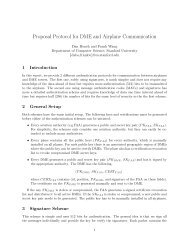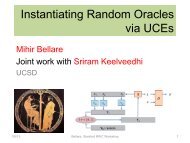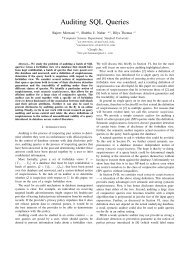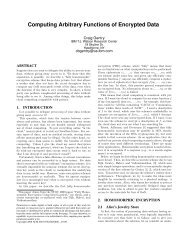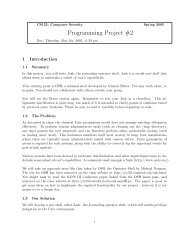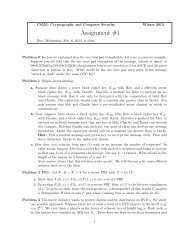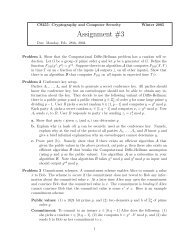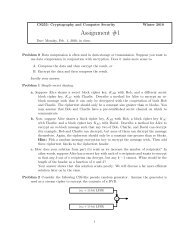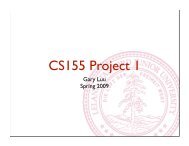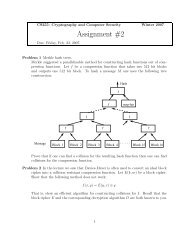PBC Library Manual 0.5.11 - Stanford Crypto Group
PBC Library Manual 0.5.11 - Stanford Crypto Group
PBC Library Manual 0.5.11 - Stanford Crypto Group
Create successful ePaper yourself
Turn your PDF publications into a flip-book with our unique Google optimized e-Paper software.
nd(G)<br />
init_pairing_A();<br />
Other sample pairings can be used by replacing A with one of D, E, F, G.<br />
Returns a random element of an algebraic structure G, e.g:<br />
g := rnd(Zr);<br />
Synonym: random.<br />
pairing(g, h)<br />
G(g)<br />
Chapter 7. Bundled programs<br />
Returns the pairing applied to g and h. The element g must be an element of G1 and h of G2, e.g:<br />
pairing(rnd(G1), rnd(G2));<br />
Maps an element g to element of the field G, e.g:<br />
Zr(123);<br />
GT([456, 789]);<br />
7.2. Parameter generation<br />
Programs that generate pairing parameters are located in the gen subdirectory. Some of the programs are<br />
already functional enough to be used to find parameters for real applications. I need to write more<br />
documentation first; for now, read the source!<br />
listmnt<br />
Searches for discriminants D that lead to MNT curves with subgroups of prime order.<br />
genaparam, gena1param, gendparam, geneparam, genfparam, gengparam<br />
Prints parameters for a curve suitable for computing pairings of a given type. The output can be fed<br />
to some of the other test programs. The programs gendparam and gengparam should be given a<br />
discriminant as the first argument.<br />
hilbertpoly<br />
Prints the Hilbert polynomial for a given range of discriminants. Computing the Hilbert polynomial<br />
is an intermediate step when generating type D parameters.<br />
32



